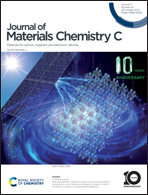Dual conductive network sensors based on an MXene/PDES supramolecular elastomer and their performance†
Abstract
Developing wearable sensors with high conductivity, stretchability, self-healing ability and good mechanical properties remains a considerable challenge. Aimed at addressing this problem, a novel strategy is proposed by constructing electronic conductive networks (MXene nanosheets) in an ionic conductive matrix (a polymerizable deep eutectic solvent). The AC conductivity at different frequencies indicated that the dual conductive networks were formed when the loading of the MXene reached 0.2 wt%. The formation of dual conductive networks was beneficial to the conductive properties and mechanical properties. The prepared sensor exhibited excellent sensing performance, such as high sensitivity, reliability and stretchability. Furthermore, the sensor had good self-healing ability due to many hydrogen bonding interactions between the PDES and MXene. The self-healing efficiency reached 75.2% for tensile strength and 87.1% for elongation at break when kept at 60 °C and 10% humidity for 4 h. Besides its excellent sensing performance, the sensor also had other advantages, such as anti-freezing at −20 °C, good adhesion with various substrates, and complete recyclability in water. The prepared sensor was successfully used in motion detection of human bodies and easily distinguished the motion of walking, jogging and running by the peak intensity, peak shape and frequency.

- This article is part of the themed collection: #MyFirstJMCC


 Please wait while we load your content...
Please wait while we load your content...